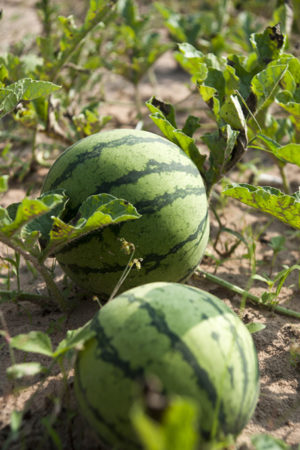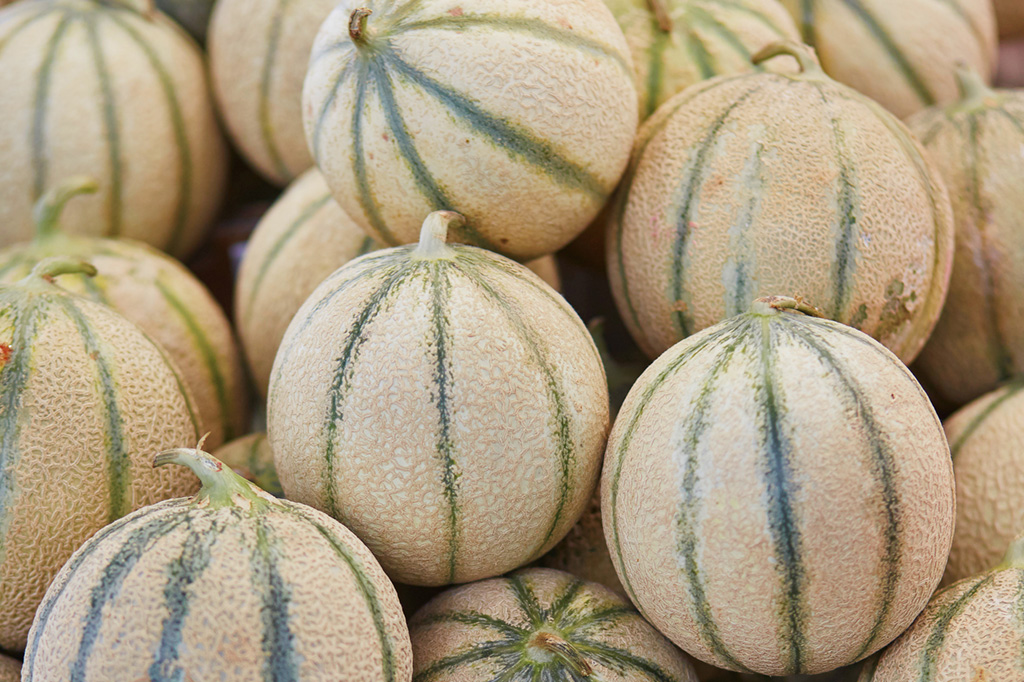Melons are a fickle fruit.
The flesh is completely concealed beneath a thick layer of tough skin, a poker face hiding what’s inside. You must cut it open and taste it to know if it’s a winning hand. That hard skin, though, is a defense mechanism.
Melons, both cucumis melo (muskmelons, cantaloupe, honeydew) and citrullus lanatus (watermelon), have been cultivated for thousands of years. In 2010, DNA testing by botanical researchers determined muskmelons originated in the Indian subcontinent, and quickly spread to Persia (modern day Iran). Prior to this discovery, it was thought sweet melons originated in Sub-Saharan Africa, as watermelons did. Melons made their way to the Americas courtesy of Christopher Columbus, when he brought seeds to the Caribbean. From there, they spread to the mainland of North, Central and South America.
Melons grow best in hot, dry places with loamy soil—in essence, the desert. The thick, tough skin protects the tender flesh from the harsh elements, creating a haven for a “sugar production factory” that matures somewhere between 65 and 100 days. When melons are vine-ripened, the flesh is sweet, juicy and refreshing. When they’re picked too early, the result is a watery, flavorless mess—money down the drain.
 How to Pick a Melon
How to Pick a Melon
Picking a good melon is somewhat of a gamble, but there are some telltale signs. Nate Jones, a third-generation farmer and owner of King’s Crown Organic Farm near Glenns Ferry, Idaho, grows organic melons for the Tuesday Ketchum farmers’ market and occasionally, when the quantity warrants, the Boise Saturday farmers’ market.
“I’ve heard them all,” he said, referring to the conventionally accepted tips for picking a ripe melon. “Thump it, press it, smell it,” he said. Occasionally that yields success, but the only way to truly know you’re getting a ripe melon is to buy it from a grower that picked the melon when it was ripe on the vine.
“We call it ‘pick to slip’,” Jones said. “Give the melon a tug and if it slips easily from the stem, 99 percent of the time, it’s ripe.”
California is the largest commercial producer of melons and watermelons, followed by Texas and Arizona. Idaho has a comparatively small melon production, most of which is grown near the Snake River in central-southern and southwestern Idaho. Melon season in Idaho begins in the middle of July and runs through the end of September, but Mother Nature can wreak havoc with the specific dates. In 2016, melon season stretched into the first week of October.
Melons Galore
Jones plants melon plants around the 10th of May. He sources out the seeding and sometimes doesn’t know which varieties he has until they bloom. By the third week of July, he begins the “pick to slip” process. As the summer progresses, he picks 10 cases a week in the beginning and up to 100 cases a week during full peak, in mid to late August. His melons continue to produce into September.
According to Amy Goldman, author of “Melons: For the Passionate Grower” (Artisan Books, 2002), “Green melons picked before their time can become juicier, but they never catch up on flavor.” Once the melon is picked, sugar production stops, so while it may ripen further, the sugar content does not increase.
Dalton James, assistant produce manager at Atkinsons’ Market in Ketchum, said in early summer, he buys melons from California, but when Idaho melon season begins, usually early July, he switches to melons from Jim Brizendine’s Hagerman Valley Produce near Bliss, Idaho, about 19 miles east of Glenns Ferry, as the crow flies.
The Hagerman area is known for producing sweet, juicy melons. “Jim grows watermelon and cantaloupes for all the Atkinsons’ Markets. Sometimes we get some honeydew along with some other specialty melons, like crenshaw, from him,” James said. “And when they come in, we’ll mark them as local melons.”
Brizendine added, “You’ve got to have good soil to get a good melon. It can’t be hard dirt, and it can’t be all sand. If you’ve got sandy loam, like we do, you can get a good melon.” He said good melons are going to be local, or at least regional, melons. “They have to pick the melons half green to account for warehousing and shipping,” he said of mass producers in other states. “You can’t get a good-tasting melon that was picked before it was ripe.”
Other melon varieties you might find in the markets include canary, Galia and Charentais, a French melon referred to as a “true cantaloupe.” Charentais are smaller than the North American variety of cantaloupe. Roughly softball size, they are silvery green, segmented with green stripes and smooth-skinned. The tan, netted-skinned variety we call cantaloupe is a muskmelon—not a true cantaloupe—though no one knows why the term cantaloupe stuck and muskmelon didn’t. The canary melon has bright yellow, smooth skin and pale green or even white flesh. Galia has netted skin like the North American cantaloupe, but is yellowish-gold in color, not tan, and the flesh is pale green.
Melons in the Kitchen
Refrigerate ripe melons, but let them return to room temperature before serving, unless you’re making a chilled soup (see recipe). Doug Jensen, executive chef of Sawtooth Brewery Public House, serves spicy watermelon gazpacho with pickled watermelon rind. Scott Mason (Ketchum Grill, Enoteca, Town Square Tavern) also serves a watermelon gazpacho with crumbled feta, inspired by a food tour of Israel. One classic pairing is prosciutto-wrapped cantaloupe, while honeydew melon loves a ginger, lime and poppy seed dressing.
But don’t underestimate the simple joy of eating melon straight up—nothing but melon—especially if that melon was left to ripen on the vine. “There are times when melons can be so disappointing. Just sweet and nothing else. Or still not quite ripe, hard and not yet at its potential,” Mason said. “When they are perfect, though, one smell, one bite, always leads to another.”
Recipe: Chilled Cantaloupe Soup
Adapted from “The Cool Mountain Cookbook” by Gwen Ashley Walters
Let this refreshing soup sit in the fridge until well chilled, at least an hour, after making it. If it separates, don’t worry, that’s natural; just stir before ladling in bowls to serve.
Makes 6 (6-ounce) servings
6 cups peeled and chopped cantaloupe (about 1-4-pound melon)
1-1/2 cups orange juice
1/4 cup fresh lemon juice
1/4 cup fresh lime juice
1 tablespoon honey
1/4 teaspoon ground cinnamon
Garnish:
1/2 cup plain yogurt
Splash of milk (whole or 2%)
1 sprig of fresh mint
Place all ingredients in a large bowl and stir. Working in two batches, place half the mixture in a blender and puree until smooth. Finish pureeing the other half and combine both pureed batches. Taste and add more cinnamon if desired.
Whisk yogurt with a small amount of milk together in a small bowl. Test consistency and add more milk to thin if necessary. You want the yogurt to “float” on top of the soup. After ladling into chilled soup bowls, drizzle with a spoon full of thinned yogurt. Strip mint leaves from stem. Roll leaves lengthwise and cut crosswise into very thin strips (called chiffonade). Sprinkle a few strands on top of the soup and serve.


